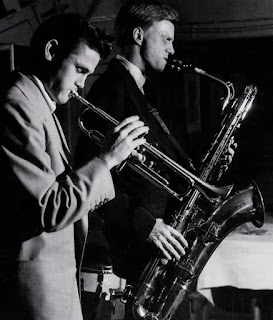Jazz and the Ambiguity of Influence, Part 4: In Praise of West Coast Jazz
 |
| Baker and Mulligan |
So what we are really talking about is California as the (perceived) home of cool jazz -- as exemplified by the Chet Baker-Gerry Mulligan Quartet, the premier white group of the time, and one of the most influential groups in jazz history. But this overlooks what might be called black cool jazz, or in some cases, black chamber jazz. A master of this category was the drummer Chico Hamilton, who made many immensely pleasurable and inventive recordings during the late 50s and 60s.* In fact, over the last couple years I have enjoyed listening to these as much or more than any other jazz on my playlist. Hamilton was African-American, but his groups actually were delightfully mixed in both race and instrumentation, featuring white players such as the jazz guitar giants Jim Hall and Gabor Szabo, as well as the innovator of jazz cello, Fred Katz. Really, Hamilton's groups were gorgeous manifestations of the cosmopolitan ideal, especially in how he wove in global sounds. Only a fool would try to determine which part of the music was "black" and which part was "white." It simply defies the misguided effort. The most significant player to emerge from Hamilton's bands was Charles Lloyd, who deserves a whole essay in himself.
So we can say without hesitation that cool jazz is not just a "white thing." Nevertheless, two of the innovators and biggest stars of the form were the white players Gerry Mulligan and Chet Baker, and represented the form in many people's minds. By considering them we can learn a lot about our through line: the ambiguity of influence. First, let's get down the the question driving this whole series: Could they swing? Yes, yes, yes, they could. Also, they helped pioneer an aesthetic innovation by including no chordal support instrument, like a piano or guitar. In other words, they are improvising without a net and fully exposed, which is stimulating. So as a group they helped influence jazz that way.
Now let's consider the individual cases of Mulligan and Baker as they pertain to the ambiguity of influence, in each case in relation to the art of Miles Davis. Miles is arguably the most influential jazz player in history, yet the mythology around him isn't quite as straightforward as is assumed. Miles acts, the others follow, etc. Case in point is Miles's legendary Birth of the Cool album, released in 1957, but consisting of tracks recorded in 1949 and 50. So what happened was that since the Miles of 1957 was the brightest light in jazz, the press retroactively crowned him the guy who took the cool movement to new levels, what with his unfathomable hipness and fearless creativity. The truth is that, alongside Miles' contributions, the Birth band featured compositions and arrangements from white musicians like Mulligan, Gil Evans, and Lee Konitz who had been helping to develop the impressionistic cool sound in the Claude Thornhill Orchestra. For his part, Davis expressed admiration for this band and never tried to take undue credit. Without a doubt, two of the main things he brought to the cool project were his gorgeous, reflective tone (hugely influential in jazz) and his peerless taste. Miles always knew what worked and didn't work and he was ruthless in emphasizing the former and jettisoning the latter. There is no doubt that sessions led by Miles would be of the highest caliber.
Okay, now for Baker. Let me just state my main point up front, which is that Baker sounds nothing at all like Miles. Nothing. The story usually goes like this. In the late 40s-early 50s, Miles innovated the introspective sound on trumpet, filled with lots of silence, which causes the listener to lean in rather than check out. Baker then picked up on it out on the West Coast and rode it to fame, maybe even capitalizing along the way on his whiteness. Well, I just don't know if the influence and the outcomes are that clear cut. Baker was developing his own sound pretty much simultaneously with Miles and besides, we already saw that the introverted trumpet sound was pioneered by Big Beiderbecke and others. Is it not possible two different people on two different coasts could be innately drawn to the same sound they hear in their minds? Actually, I think we can trace the source of this trope right to Miles himself. I've read Miles's autobiography twice as well as dozens of his interviews. And if the truth is that Miles could be extraordinarily effuse in his praise for other musicians, he could also be subject to fits of jealousy, which I think was the case when he declared Baker derivative of his own sound in an early 50s interview. So what about their individual sounds? Baker was more melodious and Miles more sophisticated and adventurous in his use of unexpected harmonies and phrasing. Another way to say it is that sometimes Baker could be easier and more fun to listen to. Ultimately, Baker decamped to Europe where he was adored and played music that was steadily more challenging than the music that, along with his looks, originally made him famous.
* On the East Coast, the sublime Modern Jazz Quartet was the exemplar of black "chamber jazz"
Comments
Post a Comment